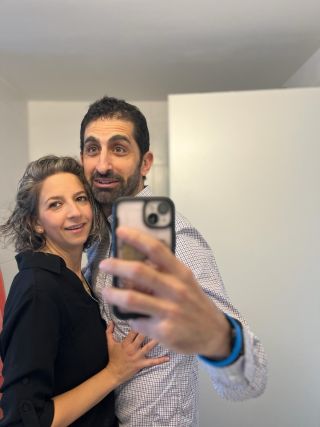Relationships
Four Gateways to Mature Intimacy
Communicating by sharing what's happening within.
Posted May 8, 2024 Reviewed by Hara Estroff Marano
Key points
- Mature intimacy occurs when both partners dare to openly feel, next to each other.
- The secret to mature intimacy is simply sharing openly what you're feeling in the moment.
- Rigid and narrow socialization or limiting core beliefs make it difficult for us to share our feelings.
Co-authored with Galit Romanelli

“I want a break,” Iris says quietly.
“We’ve been together for 20 years and I want to find out who I am.”
Terry was quiet. Not surprised, but shocked.
“I don’t know what to say.”
We asked, “Do you want me to teach you how to express your feelings? Do you want me to help you be more vulnerable?”
“Yes! I know I’m feeling things but I don’t know how to express them.”
“I’ve been ‘milking’ him for years unsuccessfully, please help him express his feelings!”
All too often in the clinic we see individuals and couples who struggle to express their emotional world. In its very gendered form we’ll see the following dynamic: men labeled as indifferent, aloof, or simply emotionally challenged; women, on the other hand, labeled as too much, too emotional, all over the place, overwhelmed, or flooded with intense emotions. Regardless of the gendered expression, all face the same challenge—connecting to themselves in a way that enables them to express what they’re feeling in order to connect to their partner.
Intimacy, or into-me-see, is the art of opening up and sharing what’s happening inside. For some, this comes naturally. For others, especially men, it is harder. Rigid and narrow socialization or limiting core beliefs have cut us people off from certain emotions. But the truth is that the ability to connect and share your emotional world is the foundation for empathy, and love.
Terry, like many men, wasn’t taught the art of emotional intimacy, which left his wife taking on the emotional labor of the relationship. This dynamic meant that Iris became the expert on his emotions, which eventually led to resentment, disempowerment, and negative sentiment override—that is, he was stuck seeing only the negative side of his partner.
The simple truth is that by openly sharing what’s happening within, you’re already on the way to mature intimacy. Yes, it’s that simple. Our definition of intimacy is: Feeling, together. Both partners openly feeling, even if it’s not the same feeling, is intimacy.
How To Practice Mature Intimacy
There are four methods we teach couples to begin practicing intimacy:
“I feel”
The first gateway seems the easiest, yet for many it's a challenge: What am I feeling right now? And if I do know what I feel, do I dare to share it with my partner?
For us to be able to share our feelings openly, we must first acknowledge them, validate them, and finally share them openly. Feelings aren’t good or bad; some are more or less pleasant, but all feelings are extremely important guideposts to learning more about ourselves.
Terry found it hard to share what he’s feeling directly, So we taught him the other three gateways.
“Part of me….” (POM)
We all have multiple self-states, and another gateway to being open and vulnerable is to share these different self-states. The beauty of POM is that it enables us to hold and share two opposing feelings at the same time, which is a sign of emotional maturity.
Upon learning this, Terry shared, “Part of me is happy for you that you want to find yourself after two kids and 20 years together. Another part of me is scared that you’ll get carried away and won’t want me anymore.”
Physical sensations
Emotions are energy in motion. Feelings are like a wave of energy and, if surrendered to, have a natural cycle of 90 seconds. The emotions live in our body and if we focus attention inward, we can uncover the physical sensations of emotions.
Take a deep cleansing breath, scan your body, looking for unique sensations: tingling, cramps, itch, warmth, coldness and more. As you become aware of sensations, share and describe them. Lean into them and explore them. As you begin to share and describe the sensations, you might notice how your felt sense changes.
Terry listened carefully and said he didn't feel anything. I told him to close his eyes and scan his body. He then shared, “I feel a knot in my stomach.”
“Great, breathe in to it… describe how that knot feels.”
“It feels hard, stuck, frozen…”
“If that knot could talk, what would it say?” We invited him to free-associate and go deeper.
“It’s scared. I'm afraid of what will happen to our family.”
We continued to expand on the topic of his fear. Then we asked him to check his stomach again.
He checked again and was surprised to discover that the knot felt looser.
Just talking about his sensations already shifted his somatic experience. Or as Dr. Daniel Siegal says, "Name it to tame it."
Broadcasting live
The last gateway isn’t necessarily focused on feelings but, rather, on internal processes. In psychotherapy it's called self-disclosure, but we prefer our playful title, "broadcasting live." Broadcasting live is agreeing to pull back the curtains on your thoughts and internal world and sharing the candid in-the-moment reality of your heart and mind. The stream of consciousness can be somewhat intimidating because you don’t necessarily know what will come out of your mouth or how your partner will react to your words. Broadcasting live might not include feeling words, but it does meet another definition of intimacy: meeting oneself in the presence of the other.
Terry began broadcasting: “I’m not really sure what to do or say now, but I am happy that you are finally clear about what you want. Now I’m worried about the girls and how they will be…”
Tears were rolling down Iris’s face as she witnessed her partner connect to himself and dare to share his internal world.
She finally let go of being responsible for his feelings and was free to feel herself. At that moment they were “feeling, together.”
And if they can do it, so can you.
Galit Romanelli is a life coach, Ph.D. candidate in gender studies, and co-director of The Potential State.
References
Brackett, M. (2019). Permission to feel: Unlocking the power of emotions to help our kids, ourselves, and our society thrive. New York, NY: Celadon Books.
Gendlin, E. T. (2003). Focusing. London, UK: Random House.
Schnarsh, D. (1997). Passionate marriage: Keeping love and intimacy alive in committed relationship. New York, NY: Owl books.
Siegel, D. J., & Bryson, T. P. (2016). No-drama discipline: The whole-brain way to calm the chaos and nurture your child's developing mind. New York, NY: Bantam.
Taylor, J. B. (2021). Whole brain living: The anatomy of choice and the four characters that drive our life. New York, NY: Hay House.



